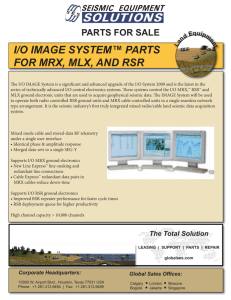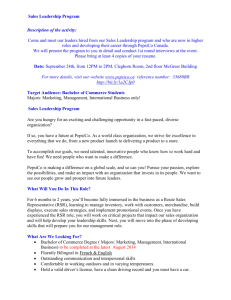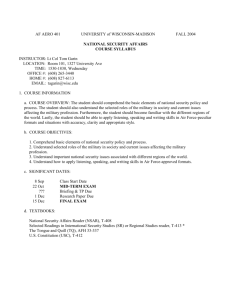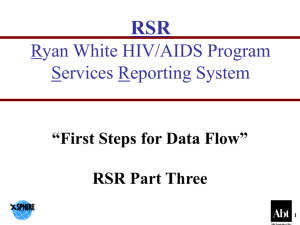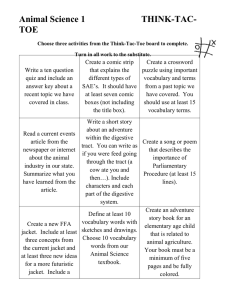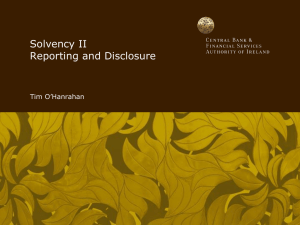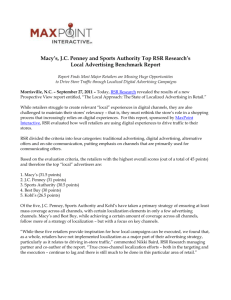Research Journal of Applied Sciences, Engineering and Technology 8(23): 2305-2314,... ISSN: 2040-7459; e-ISSN: 2040-7467
advertisement
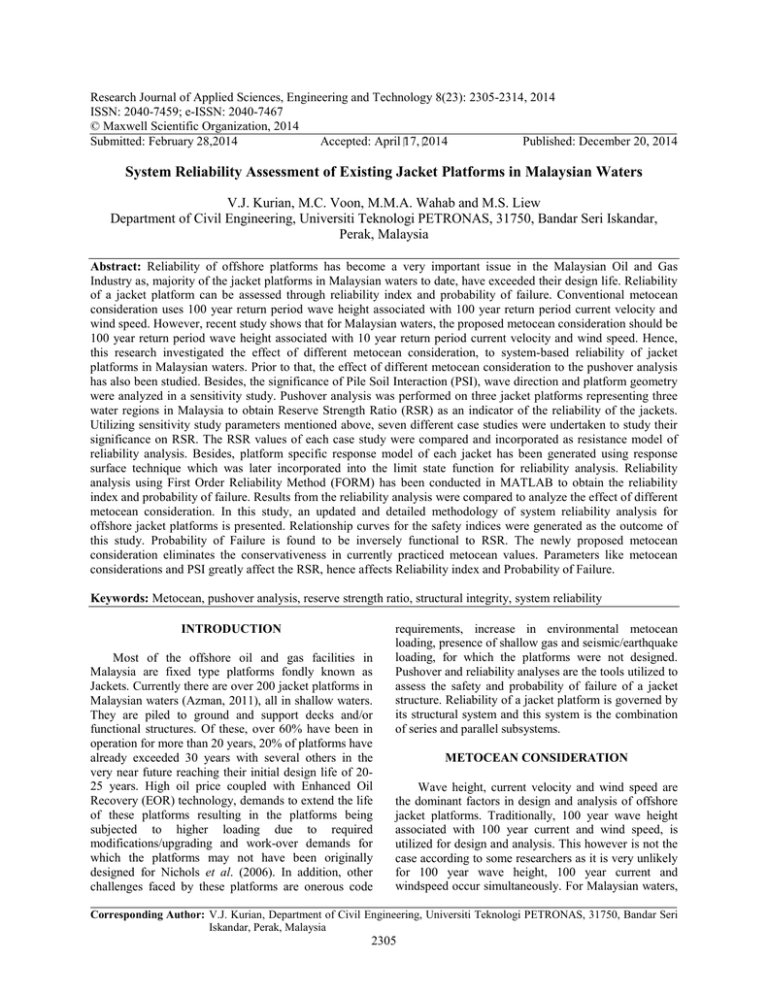
Research Journal of Applied Sciences, Engineering and Technology 8(23): 2305-2314, 2014 ISSN: 2040-7459; e-ISSN: 2040-7467 © Maxwell Scientific Organization, 2014 Submitted: February 28,2014 Accepted: April 17, 2014 Published: December 20, 2014 System Reliability Assessment of Existing Jacket Platforms in Malaysian Waters V.J. Kurian, M.C. Voon, M.M.A. Wahab and M.S. Liew Department of Civil Engineering, Universiti Teknologi PETRONAS, 31750, Bandar Seri Iskandar, Perak, Malaysia Abstract: Reliability of offshore platforms has become a very important issue in the Malaysian Oil and Gas Industry as, majority of the jacket platforms in Malaysian waters to date, have exceeded their design life. Reliability of a jacket platform can be assessed through reliability index and probability of failure. Conventional metocean consideration uses 100 year return period wave height associated with 100 year return period current velocity and wind speed. However, recent study shows that for Malaysian waters, the proposed metocean consideration should be 100 year return period wave height associated with 10 year return period current velocity and wind speed. Hence, this research investigated the effect of different metocean consideration, to system-based reliability of jacket platforms in Malaysian waters. Prior to that, the effect of different metocean consideration to the pushover analysis has also been studied. Besides, the significance of Pile Soil Interaction (PSI), wave direction and platform geometry were analyzed in a sensitivity study. Pushover analysis was performed on three jacket platforms representing three water regions in Malaysia to obtain Reserve Strength Ratio (RSR) as an indicator of the reliability of the jackets. Utilizing sensitivity study parameters mentioned above, seven different case studies were undertaken to study their significance on RSR. The RSR values of each case study were compared and incorporated as resistance model of reliability analysis. Besides, platform specific response model of each jacket has been generated using response surface technique which was later incorporated into the limit state function for reliability analysis. Reliability analysis using First Order Reliability Method (FORM) has been conducted in MATLAB to obtain the reliability index and probability of failure. Results from the reliability analysis were compared to analyze the effect of different metocean consideration. In this study, an updated and detailed methodology of system reliability analysis for offshore jacket platforms is presented. Relationship curves for the safety indices were generated as the outcome of this study. Probability of Failure is found to be inversely functional to RSR. The newly proposed metocean consideration eliminates the conservativeness in currently practiced metocean values. Parameters like metocean considerations and PSI greatly affect the RSR, hence affects Reliability index and Probability of Failure. Keywords: Metocean, pushover analysis, reserve strength ratio, structural integrity, system reliability INTRODUCTION Most of the offshore oil and gas facilities in Malaysia are fixed type platforms fondly known as Jackets. Currently there are over 200 jacket platforms in Malaysian waters (Azman, 2011), all in shallow waters. They are piled to ground and support decks and/or functional structures. Of these, over 60% have been in operation for more than 20 years, 20% of platforms have already exceeded 30 years with several others in the very near future reaching their initial design life of 2025 years. High oil price coupled with Enhanced Oil Recovery (EOR) technology, demands to extend the life of these platforms resulting in the platforms being subjected to higher loading due to required modifications/upgrading and work-over demands for which the platforms may not have been originally designed for Nichols et al. (2006). In addition, other challenges faced by these platforms are onerous code requirements, increase in environmental metocean loading, presence of shallow gas and seismic/earthquake loading, for which the platforms were not designed. Pushover and reliability analyses are the tools utilized to assess the safety and probability of failure of a jacket structure. Reliability of a jacket platform is governed by its structural system and this system is the combination of series and parallel subsystems. METOCEAN CONSIDERATION Wave height, current velocity and wind speed are the dominant factors in design and analysis of offshore jacket platforms. Traditionally, 100 year wave height associated with 100 year current and wind speed, is utilized for design and analysis. This however is not the case according to some researchers as it is very unlikely for 100 year wave height, 100 year current and windspeed occur simultaneously. For Malaysian waters, Corresponding Author: V.J. Kurian, Department of Civil Engineering, Universiti Teknologi PETRONAS, 31750, Bandar Seri Iskandar, Perak, Malaysia 2305 Res. J. App. Sci. Eng. Technol., 8(23): 2305-2314, 2014 the proposed metocean combination is 100 year wave height associated with 10 year wind and current velocity (Selamat et al., 2013). Authors considered this metocean combination along with the traditional 100 year wave, current, wind combination and also with a metocean combination which exclude wind (Ersdal, 2005). PUSHOVER ANALYSIS Pushover analysis is widely used in current offshore standards such as API, ISO and DNV to evaluate the ultimate capacity of the platform against the environmental loading (Golashani et al., 2011). Pushover Analysis will provide Reserve Strength Ratio (RSR) value to better assess the platform’s integrity (Narayanan and Kabir, 2009). Knowledge from the analysis can also be used to determine the criticality of components within the structural system and to prioritize the inspection and repair schemes (Rizal, 2011). Pushover analysis which is used to obtain the RSR values of existing aged platforms is crucial because RSR is to be used further in reliability assessment to obtain the likelihood of failure. In the pushover analysis of an offshore jacket platform, the overall structural response and capacity are dependent on the member behavior in the non-linear range of deformation and also the non-linear interaction of the foundation with the soil. Hence, the pile-soil system is modeled as part of the analysis, which considers non-linear properties of the underlying soil to achieve the most favorable capacity (Asgarian and Lesani, 2009). Thus, this work was undertaken with the aim to study the effect of different metocean considerations to the RSR. It also looks onto the influence of pile soil interaction in pushover analysis. SYSTEM RELIABILITY ANALYSIS Reliability is defined as ability to achieve desired purpose of platform under operational and extreme conditions throughout its operating life. Reliability of a jacket is measured by its reliability index and probability of failure (Kurian et al., 2012). Structural loadresistance systems are unique; hence the reliability cannot be determined from observation of failures or experimental studies. Under these circumstances, reliability needs to be calculated from predictive models and probabilistic methods. If a structure exceeds a specific limit, the structure will not be able to perform as required; the specific limit is called a limit state (Choi et al., 2006). The limit state shows the safety margin between resistance and load of the structures. The limit state function, g and probability of failure, P f is shown in Eq. (1) and (2). Failure of a structural element occurs when the Load model (L) exceeds the Resistance model (R) as shown in Fig. 1 (Stewart, 2001): g = R-L P f = P [g (·) <0] R L (1) (2) = The resistance of the system = The loading of the system The notation g (·) <0 denotes the failure region while g (·) = 0 and g (·) >0 indicates the failure surface and safe region, respectively. The reliability index or safety index, β is defined in Eq. (3): Fig. 1: Definition of probability of failure 2306 𝛽𝛽 = 𝜇𝜇 𝑅𝑅 −𝜇𝜇 𝑆𝑆 �𝜎𝜎 𝑅𝑅 2 +𝜎𝜎 𝑆𝑆 2 (3) Res. J. App. Sci. Eng. Technol., 8(23): 2305-2314, 2014 The reliability index represents the distances of the mean margin of safety from the failure surface (Choi et al., 2006). Hence, the larger the value of reliability index, the safer the structure: METHODOLOGY Pushover analysis: Pushover analysis is widely used in calculating the ultimate capacity as well as demonstrating the global instability of jacket platforms (Golashani et al., 2011). Firstly, the gravity load is applied followed by the environmental load onto the structure incrementally while the nodal displacements and element forces are calculated for each load steps and the stiffness matrix is updated. The internal forces and deformation computed at the target displacement levels are estimates of the strength and deformation demands, which need to be compared to available capacities (Krawinkler, 1996). This process will continue until the structure as a whole collapses. Figure 2 below shows the environmental load being applied onto the jacket platform until it collapses. In order to determine the ultimate strength of the platform, it requires information on the updated characteristics of the platform such as platform configuration, foundation characteristics and miscellaneous external forces on the platform (Capanoglu and Coombs, 2009). Reserve Strength Ratio (RSR) is a measure of structure's ability to withstand loads in excess of those determined from platform design. This reserve strength can be used to maintain the platform in service beyond their intended service life. Knowledge from the analysis can be used to determine the criticality of components within the structural system and used to prioritize the inspection and repair schemes (Narayanan and Kabir, 2009). RSR is the ratio of collapse base shear to the 100 year return period design base shear as shown in Eq. (4): 𝑅𝑅𝑅𝑅𝑅𝑅 = 𝐵𝐵𝐵𝐵 𝑢𝑢𝑢𝑢𝑢𝑢𝑢𝑢𝑢𝑢𝑢𝑢𝑢𝑢𝑢𝑢 𝐵𝐵𝐵𝐵 𝑑𝑑𝑑𝑑𝑑𝑑𝑑𝑑𝑑𝑑𝑑𝑑 (4) where, BSultimate is the ultimate capacity and BSdesign is design base shear loading on the jacket with respect to 100 year return period metocean loading. The minimum acceptance safety criterion of RSR for a manned structure is 1.50 (Rizal, 2011). Using commercial software, design base shear can be identified when the environmental load factor equals to 1.0, while collapse base shear is the maximum base shear at collapse. Fig. 2: Pushover analysis by increasing the load factor of environmental loading until the structure collapses Table 1: Wave properties for platform 'A', 'B' and ‘C’ 100-Year return period wave properties -------------------------------------------------------------------------------------------------------------------------------------------------------------------------------Platform 'A' Platform 'B' Platform 'C' ----------------------------------------------------------------------------------------------------------------------------------------------------------Direction H max (m) T ass (s) Direction H max (m) T ass (s) Direction H max (m) T ass (s) N (0°) 11.7 10.9 N (0°) 7.7 8.6 N (0°) 8.7 8.6 NE (45°) 11.7 10.9 NE (61°) 4.0 6.3 NE (45°) 10.9 9.5 E (90°) 8.7 9.8 E (90°) 4.0 6.3 E (90°) 6.5 7.2 SE (135°) 6.3 9.7 SE (118°) 2.3 4.7 SE (135°) 6.5 7.2 S (180°) 6.3 9.7 S (180°) 2.3 4.7 S (180°) 6.5 7.2 SW (225°) 8.7 9.8 SW (241°) 7.7 8.6 SW (225°) 7 7.7 W (270°) 10.2 10.3 W (270°) 7.7 8.6 W (270°) 7 7.7 NW (315°) 11.7 10.9 NW (298°) 7.7 8.6 NW (315°) 8.7 8.6 2307 Res. J. App. Sci. Eng. Technol., 8(23): 2305-2314, 2014 Table 2: 100-year and 10-year wind and current properties for platform ‘A’ and 'B' 100-Year return period wind and current for 'A' 100-Year return period wind and current for 'B' ----------------------------------------------------------------------------------------------------------------------------------------------------------------------------Wind speed (m/s) Current velocity (m/s) Wind speed (m/s) Current velocity (m/s) ------------------------------- ---------------------------------------------- ----------------------------------------------------------------------------------1-hour mean 20 1-hour mean 32 Surface 1.0*D 0.94 10-min mean 22 Surface 1.0*D 1.20 1-min mean 40 Mid depth 0.5*D 0.86 1-min mean 24 Mid depth 0.5*D 0.95 3-sec gust 50 Near bottom 0.1*D 0.68 3-sec gust 26 Near Seabed 0.01*D 0.55 Near Seabed 0.01*D 0.44 10-Year return period wind and current for 'A' 10-Year return period wind and current for 'B' ----------------------------------------------------------------------------------------------------------------------------------------------------------------------------Wind speed (m/s) Current velocity (m/s) Wind speed (m/s) Current velocity ------------------------------- ---------------------------------------------- ------------------------------------------------------------------------------------1-hour mean 17 1-hour mean 19 Surface 1.0*D 0.78 10-min mean 18 Surface 1.0*D 1.05 1-min mean 24 Mid depth 0.5*D 0.70 1-min mean 20 Mid depth 0.5*D 0.83 3-sec gust 29 Near bottom 0.1*D 0.56 3-sec gust 22 Near Seabed 0.01*D 0.50 Near Seabed 0.01*D 0.37 Table 3: 100-year and 10 year wind and current properties for platform ‘C’ 100-Year return period wind and current ----------------------------------------------------------------------------------------------------------------------------------------------------------------------------------Wind speed (m/s) Current velocity (m/s) 0 45 90 135 180 225 270 315 1-hour mean 23.0 Surface 1.0*D 0.82 1.29 1.29 0.86 1.47 1.47 1.47 0.82 10-min mean 25.0 Mid depth 0.5*D 0.65 1.02 1.02 0.68 1.17 1.17 1.17 0.65 1-min mean 29.0 Near bottom 0.1*D 0.38 0.60 0.60 0.40 0.68 0.68 0.68 0.38 3-sec gust 35.0 Near Seabed 0.01*D 0.18 0.28 0.28 0.19 0.32 0.32 0.32 0.18 10-Year return period wind and current ----------------------------------------------------------------------------------------------------------------------------------------------------------------------------------Wind speed (m/s) Current velocity (m/s) 0 45 90 135 180 225 270 315 1-hour mean 20.0 Surface 1.0*D 0.71 1.17 1.17 0.74 1.14 1.14 1.14 0.71 10-min mean 22.0 Mid depth 0.5*D 0.56 0.93 0.93 0.59 0.90 0.90 0.90 0.56 1-min mean 25.0 Near bottom 0.1*D 0.33 0.54 0.54 0.34 0.53 0.53 0.53 0.33 3-sec gust 30.0 Near Seabed 0.01*D 0.15 0.25 0.25 0.16 0.25 0.25 0.25 0.15 (a) (b) (c) Fig. 3: The jacket model of platform ‘A’, ‘B’ and ‘C’ from left to right, respectively Pushover analysis consists of three major steps Directional wave properties were incorporated into which are data preparation, structural modelling and the model in eight different directions, while current progressive collapse analysis. The metocean data is and wind were incorporated as similar value for all incorporated into the program to generate eight different directions due to lack of directionenvironmental loads onto the structure. Three platforms specific metocean data for platform 'A' and 'B'. were used for the analysis namely Platform 'A', 'B' and Pushover analysis was conducted on jacket platforms 'C' representing three different water regions in ‘A’, 'B' and ‘C’ as shown in Fig. 3. Platforms 'A' and 'C' Malaysia, namely Sarawak (SKO), Sabah (SBO) and are four-legged while platform 'B' is six-legged. There Peninsula (PMO). The metocean data of those were seven cases studied namely Case A, Case B, Case platforms is shown in Table 1 to 3. 2308 Res. J. App. Sci. Eng. Technol., 8(23): 2305-2314, 2014 Table 4: Pushover analysis sensitivity study Pushover analysis Case ------------------------------------------------------------------------------Conditions A B C D E F G 1 Pile Soil Interaction (PSI) X X X X X 2 Omni-direction Metocean X X 3 Multi-direction Metocean X X X X X 4 100-10-10 Metocean X X 5 Wind : 1 min mean X X X X X 6 Wind : 3 second gust X 7 Excludes wind effect X Table 5: Different cases for system reliability Case Remarks W 100 year wave and 100 year current X 100 year wave, 100 year current and 100 year wind (1 minute mean) Y 100 year wave, 10 year current and 10 year wind (1 minute mean) Z 100 year wave, 10 year current and 10 year wind (3 second gust) C, Case D, Case E, Case F and Case G. The seven different cases with their selection of scenarios are shown in Table 4. Pushover analysis was carried out using commercial software separately for eight selected loading directions namely; N (0°), NE (45°), E (90°), SE (135°), S (180°), SW (225°), W (270°) and NW (315°) for jacket 'A', jacket 'C' while jacket 'B' was assessed at N (0°), NE (61°), E (90°), SE (118°), S (180°), SW (241°), W (270°) and NW (298°). The slight difference in the direction was mainly due to the difference in the platform geometry. RSR values from Case D, Case E, Case F and Case G were used as resistance model in the limit state function in the reliability analysis. The load model and resistance model equations for Case Ware shown in Eq. (5) and Eq. (9), respectively. Since wind effect is ignored for Case W, the variables in the load model equation only consist of wave height and current. Meanwhile, wave height, current and wind were used as variables as shown in Eq. (6-8) and Eq. (10-12): Load model: • Case W: 𝐿𝐿 = α ∙ C1 ∙ (𝐻𝐻100 + 𝐶𝐶2 ∙ 𝑈𝑈100 )C 3 where, α = = 𝐻𝐻100 = 𝑈𝑈100 C1 ,C2 and C3 = (5) The uncertainty factor for load model The 100 year wave height, The 100 year current velocity Load coefficients that must be curvefitted to calculate load model for specific jacket (Ersdal, 2005) • Case X: • 𝐿𝐿 = α ∙ (C1 ∙ 𝐻𝐻100 2 + 𝐶𝐶2 ∙ 𝐻𝐻100 + C3 ∙ 𝑈𝑈100 2 + 𝐶𝐶4 ∙ 𝑈𝑈100 + C5 ∙ 𝑊𝑊100 2 + 𝐶𝐶6 ∙ 𝑊𝑊100 + 𝐶𝐶7 ) (6) • 𝐿𝐿 = α ∙ (C1 ∙ 𝐻𝐻100 2 + 𝐶𝐶2 ∙ 𝐻𝐻100 + C3 ∙ 𝑈𝑈10 2 + 𝐶𝐶4 ∙ 𝑈𝑈10 + C5 ∙ 𝑊𝑊10 2 + 𝐶𝐶6 ∙ 𝑊𝑊10 + 𝐶𝐶7 ) (7) Case Y: Case Z: Reliability analysis: 𝐿𝐿 = α ∙ (C1 ∙ 𝐻𝐻100 2 + 𝐶𝐶2 ∙ 𝐻𝐻100 + C3 ∙ 𝑈𝑈10 2 + 𝐶𝐶4 ∙ Response surface: Wave, current and wind loads are the major loads experienced by jacket platforms 𝑈𝑈10 + C5 ∙ 𝑊𝑊10 2 + 𝐶𝐶6 ∙ 𝑊𝑊10 + 𝐶𝐶7 ) (8) throughout its operation life. Probability of failure is ascertained for the assessment of jacket platform for life where, extension purpose. Existing jacket platform after α = The uncertainty factor for load model surviving severe loading condition from some storm 𝐻𝐻100 = The 100 year wave height events are considered safe for such type of storm if they 𝑈𝑈100 = The 100 year current velocity ever occur again. Authors studied the effect of different 𝑈𝑈10 = The 10 year current velocity metocean values combinations on the reliability 𝑊𝑊100 = The 100 year wind speed analysis of jacket platforms in Malaysian waters as 𝑊𝑊10 = The 10 year wind speed 1 min mean for Case Y shown in Table 5. and 3 sec gust for Case Z. Response Surface method is used to obtain a parametric representation of environmental load onto C1 , C2 , C3 , C4 , C5 , C6 and C7 are load coefficients that the platform (Petrauskas et al., 1994). The aim was to must be curve-fitted to calculate load model for specific generate the load model equation which was jacket (Cossa, 2012). incorporated in the reliability analysis. Different load model equations were identified for each case shown in Resistance model: Resistance for system reliability is Table 5. The load coefficients in the load model modelled as an ultimate capacity of the structure. The equations are different due to different metocean expected value of ultimate capacity is assumed to be consideration. Also, the load coefficients are parameters that are structural dependant and platform specific. equal to the loading multiplied with Reserve Strength Hence response surface was utilized on all three Ratio (RSR) and accounted for resistance model platforms. uncertainty. 2309 Res. J. App. Sci. Eng. Technol., 8(23): 2305-2314, 2014 where, β is the uncertainty factor for resistance model, RSR is Reserve Strength Ratio, obtained from pushover analysis on the platform using associated metocean loading, 𝐻𝐻100 is the 100 year wave height, 𝑈𝑈100 is the 100 year current velocity, C1 , C2 ,and C3 are load coefficients which were curve-fitted to calculate load model for specific jacket (Ersdal, 2005). • • Fig. 4: Curve fit for case W, X, Y and Z platform ‘A’ • Case X: 𝑅𝑅 = β ∙ RSR ∙ (C1 ∙ 𝐻𝐻100 2 + 𝐶𝐶2 ∙ 𝐻𝐻100 + C3 ∙ 𝑈𝑈100 2 +𝐶𝐶4 ∙ 𝑈𝑈100 + C5 ∙ 𝑊𝑊100 2 + 𝐶𝐶6 ∙ 𝑊𝑊100 + 𝐶𝐶7 ) (10) Case Y: 𝑅𝑅 = β ∙ RSR ∙ (C1 ∙ 𝐻𝐻100 2 + 𝐶𝐶2 ∙ 𝐻𝐻100 + C3 ∙ 𝑈𝑈10 2 + 𝐶𝐶4 ∙ 𝑈𝑈10 + (11) C5 ∙ 𝑊𝑊10 2 + 𝐶𝐶6 ∙ 𝑊𝑊10 +) Case Z: 𝑅𝑅 = β ∙ RSR ∙ (C1 ∙ 𝐻𝐻100 2 + 𝐶𝐶2 ∙ 𝐻𝐻100 + C3 ∙ 𝑈𝑈10 2 + 𝐶𝐶4 ∙ (12) 𝑈𝑈10 + C5 ∙ 𝑊𝑊10 2 + 𝐶𝐶6 ∙ 𝑊𝑊10 + 𝐶𝐶7 ) where, β = The uncertainty factor for resistance model RSR = Reserve Strength Ratio, obtained from pushover analysis on the platform using associated metocean loading 𝐻𝐻100 = The 100 year wave height 𝑈𝑈100 = The 100 year current velocity 𝑈𝑈10 = The 10 year current velocity 𝑊𝑊100 = The 100 year wind speed 𝑊𝑊10 = The 10 year wind speed; 1 min mean for Case Y and 3 sec gust for Case Z. C1 , C2 , C3 , C4 , C5 , C6 and C7 are load coefficients that were curve-fitted to calculate load model for specific jacket (Cossa, 2012). For curve fitting, static analysis for each platform was conducted for all for 4 cases to generate the responses (Base Shear) based on varying wave height as shown in Fig. 4 to 6. The Base Shear generated at all 8 directions of the platform for that particular loading direction was inputted for the curve fitting process. The data was regressed at 95% confidence level and the load coefficients were generated using least mean square method. The coefficient of determination, R2 is above 0.95 for both platform ‘A’ and ‘C’, while R2 is above 0.90 for platform ‘B’. Due to the nature of geometry of six-legged platform ‘B’, the Base Shear generated was not that consistent in all 8 directions, resulting in lower R2. The generated load coefficients are shown in Table 6 to 8 for platform ‘A’, ‘B’ and ‘C’ for all 4 cases. Fig. 5: Curve fit for case W, X, Y and Z platform ‘B’ Fig. 6: Curve fit for case W, X, Y and Z platform ‘C’ • Case W: The resistance for case approximated by the following equation: 𝑅𝑅 = β ∙ RSR ∙ C1 ∙ (𝐻𝐻100 + 𝐶𝐶2 ∙ 𝑈𝑈100 )C 3 W is Limit state equation: A failure function for the ultimate collapse of structure can be modelled using the following equation: (9) 2310 𝑔𝑔 = R − L (13) Res. J. App. Sci. Eng. Technol., 8(23): 2305-2314, 2014 Table 6: The load coefficients for platform ‘A’ Load Coeff. W X Y 0.01251 0.04232 0.04192 C1 4.359 0.09672 0.08061 C2 2.301 2.298 0.2373 C3 0.9034 0.4435 C4 -0.04453 -0.02386 C5 0.9760 0.5088 C6 0.2843 0.4315 C7 Table 7: The load coefficients for platform ‘B’ Load Coeff. W X Y 8.976e-005 0.08996 0.0914 C1 13.17 -0.05428 -0.1135 C2 3.744 -1.301 -1.471 C3 9.444 2.545 C4 -0.01863 C5 0.008581 0.6941 0.2791 C6 0.2226 0.05128 C7 Table 8: The load coefficients for platform ‘C’ Load Coeff. W X Y 0.01065 0.04664 0.04726 C1 4.928 0.2196 0.1152 C2 2.346 1.032 0.8548 C3 2.415 0.2537 C4 -0.0267 -0.01908 C5 0.6650 0.4927 C6 0.4125 0.4433 C7 Z 0.04188 0.07821 0.5075 0.5523 -0.03047 0.7178 0.1217 Z 0.09048 -0.1100 0.7819 -0.4716 -0.02307 Fig. 7: The RSR results for Jacket 'A' 0.7959 0.3432 Z 0.0474 0.1060 0.4228 -0.4468 -0.009477 0.3866 0.1253 Probability of failure is given by the probability of that failure function is equal or less than 0. The reliability analysis was conducted using First Order Reliability Method (FORM). The COV of load uncertainty is recommended at 0.15 while COV of resistance uncertainty is recommended at 0.10 (Ersdal, 2005). In this study, Reliability Analysis was conducted on all 8 directions of the platforms instead of only the most critical direction of the platform. Fig. 8: The RSR results for Jacket 'B' RESULTS AND DISCUSSION Pushover analysis: Figure 7 to 9 show the pushover analysis results for platform 'A', 'B' and 'C' respectively. Case A and Case B were compared to each other to study the effect of Pile Soil Interaction on the value of Fig. 9: The RSR results for Jacket 'C' RSR; by including PSI consideration in the pushover analysis for Case A and excluding PSI for Case B. It was observed that metocean loading affects the Besides the effect of PSI, Case B has the purpose of RSR greatly as cases which include variation in studying the geometry effect of the jacket platform by metocean for example Case C, D, E, F and G for both excluding the PSI effect in the analysis and using the jackets show variation in the RSR values. Meanwhile, same maximum metocean loading on all 8 directions. Case A and Case B which use maximum metocean Case C and Case D looked into the effect of omniloading for all directions do not display much variation direction metocean loading which is different at each in terms of RSR for all 8 different directions. It was direction with Case C excluding PSI consideration. observed that PSI is important in pushover analysis as it Cases E and F studied the proposed metocean greatly affects the RSR value too. RSR from Case B combination which was 100 year wave associated with and Case C was considerably higher than Case A and 10 year wind and current compared with Case D; to Case D, respectively, under similar circumstances observe the effect in resulting RSR. Case G was similar with the only difference being the consideration of to case D but excludes the wind effect in the pushover PSI. analysis. 2311 Res. J. App. Sci. Eng. Technol., 8(23): 2305-2314, 2014 Table 9: The result of reliability analysis result namely: Probability of failure (PoF), Reliability Index (RI) and RSR of Platform ‘A’, ‘B’ and ‘C’ for Case W, Case X, Case Y and Case Z Platform 'A' Platform 'B' Platform 'C' Case W Case W Case W --------------------------------------------------------------------------------------------------------------------------------------------------------------------Dir PoF RI RSR Dir. PoF RI RSR Dir. PoF RI RSR 0 2.16E-12 6.926 3.699 0 2.45E-07 5.031 2.441 0 5.25E-13 7.124 3.686 45 2.72E-15 7.816 5.060 61 6.12E-20 9.067 11.650 45 1.44E-05 4.183 2.010 90 2.44E-15 7.831 5.083 90 4.35E-20 9.104 12.101 90 1.02E-14 7.648 4.769 135 2.69E-19 8.904 9.708 118 1.92E-21 9.437 18.761 135 4.96E-18 8.575 7.168 180 2.76E-19 8.901 9.686 180 4.51E-21 9.347 16.296 180 4.33E-15 7.757 5.030 225 7.33E-15 7.690 4.800 241 2.11E-15 7.847 5.391 225 5.44E-13 7.119 3.962 270 5.49E-12 6.793 3.553 270 1.82E-14 7.573 4.830 270 2.06E-12 6.933 3.739 315 1.08E-10 6.350 3.149 298 1.49E-07 5.125 2.489 315 1.91E-12 6.944 3.491 Case X Case X Case X --------------------------------------------------------------------------------------------------------------------------------------------------------------------Dir. PoF RI RSR Dir. PoF RI RSR Dir. PoF RI RSR 0 1.69E-12 6.961 3.533 0 2.81E-03 2.769 1.370 0 1.58E-06 4.661 3.350 45 5.80E-14 7.421 4.060 61 5.55E-16 8.011 5.273 45 3.18E-05 3.999 1.750 90 3.00E-15 7.804 4.673 90 5.88E-15 7.718 4.659 90 2.78E-11 6.555 3.840 135 1.29E-18 8.728 7.455 118 8.77E-15 7.667 4.846 135 2.80E-12 6.889 5.731 180 5.65E-18 8.560 6.693 180 1.34E-07 5.145 2.420 180 1.25E-12 7.003 4.082 225 3.05E-13 7.198 3.840 241 7.13E-10 6.052 2.751 225 1.07E-08 5.600 3.399 270 5.79E-09 5.706 2.579 270 2.78E-12 6.890 3.425 270 4.40E-08 5.350 3.130 315 2.09E-09 5.877 2.670 298 1.48E-04 3.618 1.626 315 2.48E-06 4.567 3.220 Case Y Case Y Case Y -----------------------------------------------------------------------------------------------------------------------------------------------------------------Dir. PoF RI RSR Dir. PoF RI RSR Dir. PoF RI RSR 0 3.13E-13 7.195 3.807 0 8.78E-07 4.780 2.082 0 1.03E-07 5.193 3.710 45 5.11E-15 7.738 4.540 61 1.78E-20 9.201 11.351 45 5.83E-06 4.384 1.900 90 5.80E-18 8.557 6.489 90 8.05E-21 9.286 12.581 90 8.51E-13 7.057 4.400 135 1.67E-19 8.957 8.717 118 4.80E-20 9.094 11.321 135 6.11E-16 8.005 6.401 180 3.94E-19 8.862 8.082 180 5.55E-17 8.276 6.260 180 1.18E-14 7.630 5.246 225 3.51E-14 7.488 4.260 241 1.05E-14 7.644 4.385 225 1.22E-09 5.965 4.213 270 3.61E-11 6.516 3.185 270 3.83E-15 7.773 4.588 270 2.57E-09 5.843 4.038 315 3.63E-10 6.160 2.880 298 1.21E-07 5.163 2.270 315 1.09E-07 5.183 3.696 Case Z Case Z Case Z --------------------------------------------------------------------------------------------------------------------------------------------------------------------Dir. PoF RI RSR Dir. PoF RI RSR Dir. PoF RI RSR 0 1.06E-12 7.027 3.606 0 4.03E-05 3.943 1.729 0 1.08E-06 4.738 2.755 45 2.43E-14 7.536 4.220 61 3.55E-19 8.873 8.614 45 3.39E-05 3.984 1.760 90 1.55E-15 7.889 4.831 90 1.40E-18 8.719 7.670 90 2.04E-07 5.066 3.619 135 1.14E-18 8.743 7.516 118 5.35E-18 8.566 7.522 135 5.65E-08 5.305 5.301 180 1.87E-18 8.686 7.233 180 1.73E-12 6.958 3.774 180 8.01E-09 5.650 4.537 225 1.28E-13 7.316 3.990 241 4.43E-13 7.147 3.707 225 1.71E-06 4.644 3.980 270 5.57E-10 6.092 2.837 270 8.65E-14 7.368 3.970 270 1.14E-05 4.235 3.271 315 1.42E-09 5.940 2.715 298 2.28E-06 4.584 1.983 315 3.64E-05 3.967 3.110 The RSR values were incorporated into the From the results, it was observed that Case E and reliability analysis as such; RSR from Case D was used Case F which consider metocean combination of 100 in reliability analysis Case X, RSR from Case E into year wave associated with 10 year current and wind Case Y, RSR from Case F into Case Z and RSR from produces RSR which is generally higher than Case D Case G into Case W, respectively. which considers 100 year return period for wave, current and wind. For Case G, metocean loading of Reliability analysis: Table 9 shows the result of only wave and current was used for the pushover Reliability Analysis for three jacket platforms studied analysis and the RSR produced was observed to be for Case W, Case X, Case Y and Case Z. The much higher than case D as well. This is especially information from the table includes the Probability of obvious for jacket 'B' since the adopted 100 year Failure (PoF) at each direction of the jacket platforms, windspeed was 40 m/s which contributed significantly the corresponding Reliability Index (RI) and RSR. The to the loading onto the platform. Although the RSR category of the four cases studied is as explained in values of case D was not the most critical compared to Table 5. Case A, B and C, it is the closest estimate to the real It was observed that Probability of Failure is existing platform’s strength considering the inversely related to the RSR. The larger the value of conventional metocean. Case E, Case F and Case G RSR means the safer the jacket platform as higher RSR were compared to Case D as only the metocean value means the platforms having higher reserve consideration was different while other conditions were capacity against the imposing environmental loadings. the same. 2312 Res. J. App. Sci. Eng. Technol., 8(23): 2305-2314, 2014 Fig. 10: Probability of failure vs. RSR and reliability index vs. RSR for case W Fig. 11: Probability of failure vs. RSR and reliability index vs. RSR for case X Fig. 12: Probability of failure vs. RSR and reliability index vs. RSR for case Y Meanwhile, the higher value of Probability of Failure means that the likelihood of a platform failure is higher, hence the lower the value of Probability of Failure, the safer the platform is. Reliability Index represents the distance of the mean margin of safety from the failure surface and is usually presented alongside with Probability of Failure as a safety index, in which the higher the value of Reliability Index, the safer the platform is. The relationship of these three results can be observed in Fig. 10 to 13. The results plotted in Fig. 10 to 13 is combination of all three platforms with all the directional values. The higher the value of RSR, it was observed that the corresponding Probability of Failure is lower for all four cases corresponding to higher Reliability Index. This applies to all four cases studied. For simplicity of discussion, authors discuss the reliability analysis in terms of Probability of Failure hereafter. Case W and Case X were compared to each other to study the effect of wind on the value of Probability of Failure. Case Y and Case Z were looked into the effect of newly proposed metocean condition against Case X with the only difference between Case Y and Case Z is in the frequency of wind used. It was observed that the Probability of Failure of Case W is generally lower than Probability of Failure of Case X. This shows that the wind loading greatly affects the difference of Probability of Failure between Case W and Case X, especially for Platform ‘B’ because the wind speed imposed on platform ‘B’ is much higher compared to the other two platforms as shown in Table 2 and 3. Hence, it was not surprising to observe the drastic increase in Probability of Failure for platform ‘B’ when wind is included. From the results, it is noticeable that Case Y and Case Z generally have Probability of Failure lower than Case X as Case Y and Case Z utilizes different metocean combination from Case X which is the current industry practice. Results also show that Probability of Failure in Case Z is slightly higher as compared to Case Y due to different frequency of wind used which are three second gust for Case Z and one minute mean for Case Y. This difference in result implicates that even though the return period of the metocean is the same, different types of wind frequency greatly influence the reliability indices of jacket platforms. CONCLUSION By performing pushover and reliability analyses, the safety indices of jacket platforms can be determined. These analyses are necessary to identify the integrity and fit-for-purpose of any aging jacket platforms for the extension of life. In this study, comparison between conventional metocean values and newly proposed metocean values were conducted. Fig. 13: Probability of failure vs. RSR and reliability index vs. RSR for case Z Sensitivity study to assess the significance of 2313 Res. J. App. Sci. Eng. Technol., 8(23): 2305-2314, 2014 parametric values was done prior to reliability analysis. Response Surface method was used to generate platform specific load and resistance model to be used in the reliability analysis. Curve fitting method was used to identify the response surface load coefficients in the analysis. FORM in MATLAB was adopted as the tool in assessing the limit state function in the reliability analysis. Relationship curves for the safety indices were generated as the outcome of this study. The following conclusions were drawn from the results of this study: • • • • • Pushover analysis using the newly proposed metocean combination of 100 year wave height associated with 10 year of current and 10 year of wind speed generally results in smaller RSR than currently practiced metocean combination values. Metocean combinations, directions and pile soil interaction greatly affect the RSR and hence affect Reliability index and Probability of Failure. The newly proposed metocean consideration in both cases of Y and Z with a difference of wind speed frequency of one minute mean and three second gust, respectively, generally result in lower Probability of Failure than Case X which utilized conventional metocean consideration. Probability of Failure is inversely functional to RSR. The lower the value of Probability of Failure or the higher the value of the RSR, the safer or more reliable the platforms are. From relationship curves, smaller RSR values produce abruptly changing Probability of Failure and vice versa. ACKNOWLEDGMENT The authors would like to acknowledge the financial support and project data given by PETRONAS and Universiti Teknologi PETRONAS for the provision of facilities and staff support. REFERENCES Asgarian, B. and M. Lesani, 2009. Pile-soil-structure interaction in pushover analysis of jacket platforms using fiber elements. J. Constr. Steel Res., 65: 209-218. Azman, M.F.N., 2011. Sensitivity study of environmental load to reliability index for Malaysian region. M.Sc. Thesis, Universiti Teknologi Petronas, Malaysia. Capanoglu, C. and S. Coombs, 2009. Requalification process for existing platforms implications of newly acquire criteria on mitigation. Proceeding of 19th International Offshore and Polar Engineering Conference, Osaka, Japan. Choi, S.K., R.V. Grandhi and R.A. Canfield, 2006. Reliability-based Structural Design. Springer, London. Cossa, N.J., 2012. Environmental load factor for ISO design of tubular joints of a Malaysia fixed offshore steel jacket platform. M.Sc. Thesis, Universiti Teknologi PETRONAS, Malaysia. Ersdal, G., 2005. Assessment of existing offshore structures for life extension. Ph.D. Thesis, Department of Mechanical and Structural Engineering and Material Science, Faculty of Science and Technology, University of Stavanger. Golashani, A.A., V. Bagheri, H. Ebrahimian and T. Holmas, 2011. Incremental wave analysis and its application to performance-based assessment of jacket platforms. J. Constr. Steel Res., 67(2011): 1649-4657. Krawinkler, H., 1996. Pushover analysis: why, how, when and when not to use it. Proceeding of the 65th Annual Convention, Structural Engineers Association of California, October 1996. Kurian, V.J., Z. Nizamani, M.S. Liew and M.M.A. Wahab, 2012. System reliability for jacket platform subjected to wave and current loads. Proceeding of International Conference on Civil, Offshore and Environmental Engineering. Narayanan, S.P. and M.B.M.A. Kabir, 2009. Structural integrity management for fixed offshore platforms in Malaysia. Proceeding of International Conference on Civil and Environmental Engineering (ICCEE, 2009). Venice Italy. Nichols, N.W., T.K. Goh and H. Bahar, 2006. Managing structural integrity for aging platform. Proceeding of the SPE Asia Pacific Oil and Gas Conference and Exhibition. Adelaide, Australia, No. SPE101000. Petrauskas, C., D.L.R. Botelho, W.F. Krieger and J.J. Griffin, 1994. A reliability model for offshore platforms and its application to ST151 “H” and “K” platforms during hurricane Andrew (1992). Proceeding of the International Conference on Behaviour of Offshore Structure System (Boss-94). Massachusetts, USA. Rizal, A., 2011. Global ultimate strength analysis for SBO platform: SMJT-E. Group Technical Soulution (GTS). Report ID: RD-PLE-CSP-RBIS309. Selamat, I.M., M.S. Liew, M.N. Abdullah and V.J. Kurian, 2013. Extreme value analysis and joint density of Metocean loads for Malaysian water. Malays. J. Civ. Eng., 25(1): 40-52. Stewart, M.G., 2001. Reliability-based assessment of ageing bridges using risk ranking and life cycle cost decision analyses. Reliab. Eng. Syst. Safe., 74: 263-273. 2314
